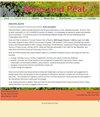Identification and classification of unmapped blanket bogs in the Cordillera Cantábrica, northern Spain
IF 1.5
4区 环境科学与生态学
Q4 ENVIRONMENTAL SCIENCES
引用次数: 3
Abstract
Blanket bogs are rare types of peatland that are recognised internationally for important habitat provision, and nationally and locally as important carbon stores and sinks. These ecosystems enjoy particular attention and protection within the European Union, but gaps highlighted in the Spanish national peatland inventory leave many areas of Spain’s blanket bog habitat unprotected and exposed to anthropogenic pressures such as livestock or wind farm development. This research identifies and offers classification of four currently unmapped areas of blanket bog located in the Cordillera Cantabrica (north Spain) on the administrative boundaries between the regions of Cantabria and Castilla y Leon. Peat depth was surveyed on a 15 m spaced grid at all sites and mesotope units were defined from topography and hydrological flow patterns. Two sloping and two mound blanket bogs were identified containing a range of bog and fen mesotope units. Maximum peat depth at the five sites ranges from 1.78 to 2.82 m covering an area of 43 ha of blanket bog (> 30 cm peat depth). The survey also estimates that more than 300,000 m3 of peat has accumulated across all sites. This study adds significantly to the known global distribution of blanket mire and suggests that an urgent update of national peatland inventories is needed more widely, not least in Spain, to identify currently unmapped areas of blanket bog. The approach used here can be employed wherever blanket mires occur in the world to promote their designation and the preservation of peatland diversity and carbon storage.西班牙北部科迪勒拉-坎塔布里卡未绘制覆盖沼泽的识别和分类
毯状沼泽是一种罕见的泥炭地类型,在国际上被公认为重要的栖息地,在国家和地方都被公认为是重要的碳储存和碳汇。这些生态系统在欧盟范围内受到特别关注和保护,但西班牙国家泥炭地名录中强调的差距使西班牙的许多覆盖沼泽栖息地没有得到保护,并面临牲畜或风电场开发等人为压力。这项研究确定了坎塔布里亚和卡斯蒂利亚-莱昂地区之间行政边界上的科迪勒拉-坎塔布里察(西班牙北部)四个目前未绘制地图的覆盖沼泽区,并对其进行了分类。所有地点的泥炭深度都在间隔15m的网格上进行了测量,并根据地形和水文流动模式定义了中上层单元。发现了两个斜坡和两个土丘覆盖沼泽,其中包含一系列沼泽和沼泽中上层单元。五个地点的最大泥炭深度为1.78至2.82米,覆盖43公顷的覆盖沼泽(泥炭深度>30厘米)。调查还估计,所有地点都积累了超过300000立方米的泥炭。这项研究大大增加了已知的覆盖沼泽的全球分布,并表明需要更广泛地紧急更新国家泥炭地名录,尤其是在西班牙,以确定目前未绘制的覆盖沼泽区域。这里使用的方法可以在世界上任何地方使用,以促进其指定以及泥炭地多样性和碳储存的保护。
本文章由计算机程序翻译,如有差异,请以英文原文为准。
求助全文
约1分钟内获得全文
求助全文
来源期刊

Mires and Peat
ENVIRONMENTAL SCIENCES-
CiteScore
2.30
自引率
16.70%
发文量
0
审稿时长
33 weeks
期刊介绍:
Mires and Peat is a peer-reviewed internet journal focusing specifically on mires, peatlands and peat. As a truly “free-to-users” publication (i.e. NO CHARGES to authors OR readers), it is immediately accessible to readers and potential authors worldwide. It is published jointly by the International Peatland Society (IPS) and the International Mire Conservation Group (IMCG).
Mires and Peat is indexed by Thomson Reuters Web of Science (2017 Impact Factors: 1.326 [two-year] and 1.638 [five-year]), Elsevier Scopus, EBSCO Environment Complete, CABI Abstracts, CSA Proquest (including their Aquatic Science and Fisheries Abstracts ASFA, Ecology, Entomology, Animal Behavior, Aqualine and Pollution databases) and Directory of Open Access Journals (DOAJ). Mires and Peat also participates in the CABI Full Text Repository, and subscribes to the Portico E-journal Preservation Service (LTPA).
Mires and Peat publishes high-quality research papers on all aspects of peatland science, technology and wise use, including:
ecology, hydrology, survey, inventory, classification, functions and values of mires and peatlands;
scientific, economic and human aspects of the management of peatlands for agriculture, forestry, nature conservation, environmental protection, peat extraction, industrial development and other purposes;
biological, physical and chemical characteristics of peat; and
climate change and peatlands.
Short communications and review articles on these and related topics will also be considered; and suggestions for special issues of the Journal based on the proceedings of conferences, seminars, symposia and workshops will be welcomed. The submission of material by authors and from countries whose work would otherwise be inaccessible to the international community is particularly encouraged.
 求助内容:
求助内容: 应助结果提醒方式:
应助结果提醒方式:


